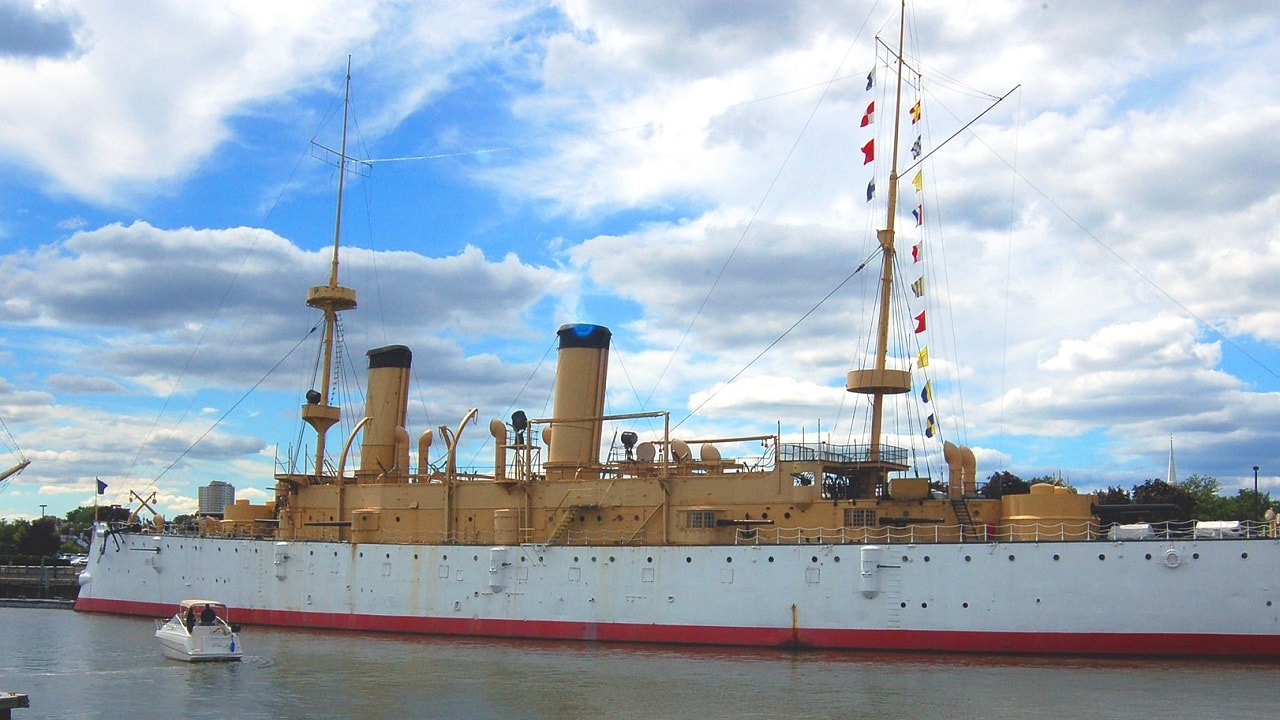Just recently, National Capital Commandery (NOUS) toured the iconic warship USS Olympia in commemoration of the 125th anniversary of the Battle of Manila Bay. The tour reflected on the vessel, the battle, and the men who served aboard her during that battle.
USS Olympia Brief History & Ship Specifications
The USS Olympia was a protected cruiser. The class of ship earned the distinction due to its armored deck, which offered protection for vital machine spaces from fragmentation of shells exploding overhead.
Olympia – named for the capital city of Washington state – was built by the Union Iron Works in San Francisco, Calif., and had her keel laid down on June 17, 1891, followed by her launching on November 5, 1892, and her commissioning on November 5, 1895.
As noted by the Historic Naval Ships Association, she is “The oldest steel-hulled American warship afloat.” The article adds that “the cruiser was born out of a program of ships for the ‘New Navy’ of the 1880s and 1890s designed to correct the deficiencies of a weakened and neglected naval force. This program was directly responsible for the rise of the steel shipbuilding industry of the United States. Olympia is the last remaining ship built during that program and the sole surviving naval combatant of the Spanish-American War.”
She boasted a hull length of 344 feet, a beam of 53 feet, a draft of 21 feet 6 inches, and a displacement of 5,870 tons. Her armament consisted of four 8-inch main guns, ten 5-inch guns, and fourteen 6-pounder guns. The Max speed was 21.7 knots (25 mph) and the crew complement was 33 officers and 396 enlisted sailors.
Besides the Spanish-American War, one of Olympia’s other historical claims to fame was carrying the remains of World War I’s Unknown Soldier from France to Washington, D.C. in 1921, whereupon his body was interred at Arlington National Cemetery.
USS Olympia was decommissioned for the last time in 1922 and saved from scrapping in 1954. In 1996, she was entrusted to the Independence Seaport Museum in Philadelphia, Pennsylvania, where she proudly sits today alongside the submarine USS Becuna. The warship is a National Historic Landmark and her triple expansion engines are Historic Engineering Landmarks.
The Battle in Brief
“You may fire when ready, Gridley.” That is arguably one of the Top 5 most famous lines uttered by a U.S. Navy leader, right up there with “Don’t Give Up The Ship,” “I have not yet begun to fight,” “Damn the torpedoes, full speed ahead,” and “I intend to go in harm’s way.” (“Dixon to carrier: Scratch one flattop” gets Honorable Mention.) The line was of course, uttered by then-Commodore George Dewey (1837-1917) to Olympia’s then-skipper, Capt. Charles Vernon Gridley … but hey, we’re getting ahead of ourselves here!
In a brief report, the Battle of Manila Bay, which commenced on May 1, 1898, was the first major battle of the Spanish-American War as well as one of the most decisive battles in naval history, set the tone for the United States’s smashing victory in the war that in turn truly established the U.S. as a world power.
During the battle, USS Olympia served as Dewey’s flagship, which put him in a prime position both literally and figuratively to issue that famous directive to Capt. Gridley.
Many people around the world, including many in Spain, believed that the Americans would be no match for the Spanish, at least on the high seas … and then reality set in. When all was said and done, seven Spanish vessels were sunk with 77 Spaniard sailors KIA, in exchange for one American cruiser damaged and one death … due to a heart attack.
Dewey was eventually awarded the rank of Admiral of the Navy, the only person in American naval history to be so honored. His Spaniard counterpart from the battle, Contralmirante (Rear Admiral) Patricio Montojo y Pasaron (1839-1917), was scapegoated, court-martialed, and imprisoned, but Dewey, in the spirit of chivalry that was still practiced in wars back then, actually wrote a letter on Pasaron’s behalf.
The Ceremony: Honoring Chief Randall
That lone American death in the battle was Chief Engineer Francis B. Randall of the U.S. Revenue Cutter Service, the predecessor to the U.S. Coast Guard. A U.S. Senate Committee on Pensions report indicates that Chief Randall had joined the Revenue Service on June 17, 1874, at the age of 24, earned his promotion to Chief Engineer on June 6, 1885, and was a mere 48 years old at his untimely passing.
Appropriately, in addition to the wreath laid in honor of the crew of the Olympia and veterans of the Battle of Manila Bay in general, the NOUS officers present for the ceremony laid a wreath in honor of Chief Engineer Randall.
Inclement Philly weather, unfortunately, prevented a thorough tour of the topside of the warship, but we still got to see plenty of cool stuff belowdecks, including the breeches of the 5-inch and 6-pounder guns, the Admiral’s Cabin, and the Admiral Head and Bath, along with plaques dedicated to Manila Bay. The smokestacks are an impressive sight to behold in-person.
MORE: Zumwalt – The Navy’s Stealth Destroyer Firing Hypersonic Missiles?
MORE: Could the U.S. Navy Bring Back Battleships?
Christian D. Orr is a former Air Force Security Forces officer, Federal law enforcement officer, and private military contractor (with assignments worked in Iraq, the United Arab Emirates, Kosovo, Japan, Germany, and the Pentagon). Chris holds a B.A. in International Relations from the University of Southern California (USC) and an M.A. in Intelligence Studies (concentration in Terrorism Studies) from American Military University (AMU). He has also been published in The Daily Torch and The Journal of Intelligence and Cyber Security. Last but not least, he is a Companion of the Order of the Naval Order of the United States (NOUS).

